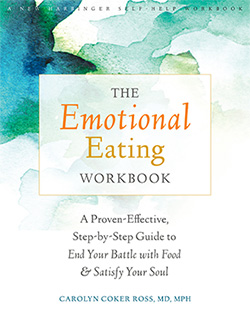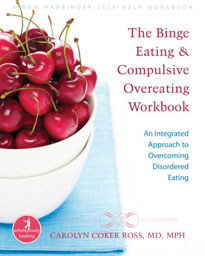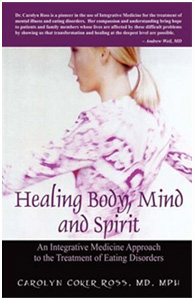![]() Eating disorders are often misunderstood. Considering an eating disorder as only food-related minimizes the deeper-rooted issues behind the unhealthy behavior. Learning how to overcome an eating disorder is not as straightforward as others believe for someone suffering from it. Untangling the interwoven threads of past trauma, discrimination and patterns to address the issue effectively requires professional intervention, empathetic support and the inner strength to embark on an authentic journey of self-awareness.
Eating disorders are often misunderstood. Considering an eating disorder as only food-related minimizes the deeper-rooted issues behind the unhealthy behavior. Learning how to overcome an eating disorder is not as straightforward as others believe for someone suffering from it. Untangling the interwoven threads of past trauma, discrimination and patterns to address the issue effectively requires professional intervention, empathetic support and the inner strength to embark on an authentic journey of self-awareness.
Misconceptions about eating disorders can create insurmountable obstacles for those impacted.
Stigmas around food norms are so prevalent that someone struggling with unhealthy eating behaviors may feel deeply shameful; therefore, they avoid seeking help. Individually, discrimination around race and eating disorders presents unique challenges, and when they intersect, the difficulties one faces may feel insurmountable.
In the workplace, the impact of this can be devastating if not adequately addressed. Understanding misconceptions, especially regarding race, is vital. When leaders prepare to delve into this sensitive topic, it is beneficial to engage the support of a DEI consultant who can provide tools, resources, insights and practical strategies for doing so with empathy.
A Close Look at the Intersection of Race and Adult Eating Disorders
Race’s impact on adult eating disorders is a complex issue that requires thoughtful consideration, especially for leaders striving to create inclusive, equitable and supportive work environments. Cultural factors, societal pressures and limited access to quality healthcare all play a significant role in eating disorders among adults and influence the way different races experience and manage eating disorders.
In any workplace, there are likely several employees quietly suffering from issues related to body image and food. The stigma surrounding mental health in some cultures may deter these individuals from seeking help, leading to delayed diagnosis and treatment. When working with employees of diverse races and backgrounds, a leader cannot adopt a one-size-fits-all approach to address the impact of these issues on the workplace culture.
It is imperative to recognize the nuanced ways in which race impacts adult eating disorders. This knowledge is crucial for a leader’s ability to offer empathetic support that meets each employee’s unique needs in a culturally sensitive manner and encourages them to obtain the life-saving eating disorder intervention they desperately need.
The Diverse Influence of Identity on Eating Disorders
One’s sense of self is a complex narrative encompassing race, ethnicity, gender, sexuality and more. Often, these identities conflict with each other rather than existing in perfect harmony, and some rise to the surface while others hide deep inside.
Recent research has shed light on how individuals from diverse backgrounds confront distinct challenges related to eating disorders. For instance, a study focusing on young Black women with larger body sizes revealed alarming statistics about the development of eating disorders. It was found that 81% of participants reported encountering racial discrimination and demonstrated a direct correlation to increased tendencies toward both overeating and Loss of Control (LOC) eating compared to periods when they did not face such discrimination. This study is just one indicator that there is a profound need to address the impact of race on the development of eating disorders.
Common Misconceptions Surrounding Eating Disorders
Certain stereotypes erroneously suggest that eating disorders exclusively impact young white women, diminishing the experiences of other races. These mistaken beliefs can impede early diagnosis and appropriate treatment of eating disorders, resulting in prolonged distress for affected individuals. Leaders should be cognizant of this issue and learn how best to support employees as they struggle to overcome an eating disorder.
Cultural Norms and Eating Disorders
Cultural ideals of beauty and body image can significantly impact one’s perception of self-worth and influence their relationship with food. In many societies, pursuing the “perfect body” fosters a culture that associates thinness with success, acceptance and attractiveness. This perspective is prevalent in the workplace, with racial and body discrimination often hindering career advancement. This mindset can exert immense pressure on minorities to conform to societal norms, often at the expense of their physical and mental health. Compounding this issue are misconceptions about eating disorders, which directly impact one’s willingness to seek intervention for an eating disorder.
In certain cultures, there exist factors that inadvertently fuel the emergence of adult eating disorders. Take, for instance, the idealization of extreme thinness in many societies, which can precipitate harmful eating behaviors among individuals striving to attain this unfair standard.
Conversely, many cultures practice behaviors that foster healthy relationships with food and body image. This may manifest as an emphasis on communal meals, where food serves not only as sustenance but as an avenue for connection and celebration. Practices such as these nurture a positive perspective, underscoring culture’s role in shaping attitudes toward food and one’s body. Instances such as this, where race and eating disorders are positively intertwined, can also be highlighted in the modern workplace to inspire a healthier outlook for the entire team.
A Historical Perspective Influencing Today’s Body Images
Throughout history, beauty norms have evolved, often mirroring cultural, economic, racial, gender and artistic perspectives. Each era’s historical precedent has left an indelible mark on how body image is perceived today.
White Privilege Weighs Heavily on Beauty Norms
Historically, white privilege has been linked to idealized beauty standards that predominantly uphold Eurocentric features. These standards, perpetuated through various channels such as media, fashion and advertising, consistently reinforce the belief that specific physical attributes are superior to others. This privilege also translates to a lack of representation and diversity in society’s beauty norms. Furthermore, its influence can extend to healthcare, where providers may be less likely to recognize and diagnose eating disorders or provide appropriate treatment for BIPOC and marginalized groups.
The Damaging Impact of Historical Body Image Stereotyping
Historical stereotypes have profoundly shaped body perceptions among many racial and ethnic communities. For example, during the slave trade, Black individuals were unjustly portrayed as “gluttonous,” underscoring the detrimental connection between the Black identity and excessive eating. As the number of mixed-race individuals increased, the correlation between thinness and superiority within the dominant white population was further established.
These stereotypes, which perpetuate fatphobia, persist today. The pressure this exerts on marginalized groups to adhere to societal body norms is massive and deeply damaging.
The Enduring Impact of Historical and Generational Trauma
Historical and generational racial trauma can significantly contribute to the development and exacerbation of eating disorders within minority populations. This deep-rooted trauma can manifest in unhealthy relationships with food and body image as one struggles to cope with intense emotional distress.
Research indicates that individuals who have endured childhood trauma, encompassing physical, emotional, or sexual abuse, exhibit an elevated vulnerability to developing disordered eating behaviors. A closer examination of these experiences within various racial identities illuminates the distinct challenges confronted by individuals from diverse backgrounds.
Emerging research demonstrates that the effects of trauma can be passed down from one generation to the next. Essentially, an ancestor’s trauma can influence their descendant’s eating disorder. While this area of study is in its early stages, insights arising from research on other forms of intergenerational trauma, such as in the descendants of Holocaust survivors, indicate the potential inheritance of biochemical alterations in genes associated with stress responses.
Dissecting Racial Disparities in Diagnosis and Treatment
Individuals from diverse racial backgrounds often face significant obstacles in getting accurate diagnoses of and subsequent treatment for an eating disorder. These disparities can stem from cultural biases, a lack of diversity and cultural competence among healthcare providers, and unequal access to mental health resources.
Healthcare professionals, typically trained to identify eating disorders according to primarily white-centered criteria, may unintentionally fail to recognize or misdiagnose such disorders in individuals from diverse backgrounds. This divergence in diagnostic standards can lead to treatment delays and worsen the eating disorder’s severity.
There is a disturbing trend where certain racial groups are less inclined to seek professional help for their eating disorders. This distinction can be directly linked to the stigma and![]() cultural attitudes surrounding mental health and body image, limited access to diverse providers and culturally competent care, and an overall lack of trust in healthcare systems.
cultural attitudes surrounding mental health and body image, limited access to diverse providers and culturally competent care, and an overall lack of trust in healthcare systems.
3 Ways to Advance Equity in Diagnosis and Treatment
One’s challenges with food and body image, exacerbated by racial discrimination, can affect their overall productivity and positivity. Advancing equity in the diagnosis and treatment of eating disorders is not just a moral decision, it’s also a strategic investment in organizational transformation.
1. Making Practices Culturally Sensitive
Cultural sensitivity is essential for breaking down obstacles in addressing eating disorders among diverse racial groups. Leaders, therapists, healthcare providers, treatment centers and support networks should adapt their approach to embrace the cultural values, traditions, and norms that shape how individuals perceive food and body image. Only by prioritizing cultural sensitivity and working collaboratively can real change occur.
2. Meaningful Representation Matters
When an individual from a diverse racial background sees themselves in their healthcare provider, therapist and support network, they are much more likely to feel comfortable in treatment, therefore increasing its efficacy. Feeling seen, heard and understood is integral to one’s ability to accept and embrace treatment for highly personal challenges, such as eating disorders.
3. Increasing Community and Professional Awareness
Efforts to educate the general public, other leaders and healthcare professionals about the relationship between race and eating disorders can result in more accurate diagnoses, targeted treatment strategies and improved outcomes.
Develop Equitable and Inclusive Approaches to Overcome Eating Disorders
Recognizing the diverse factors contributing to eating disorders, specifically race, is pivotal for tailoring interventions. Understanding the relationship between race and eating disorders is also necessary to facilitate a leader’s ability to comprehensively support employees in a way that works for their unique needs. Guided by the masterful advice of a DEI consultant or speaker, leaders can foster an environment of understanding and accessibility. An expert DEI speaker can also contribute profound insight into how race contributes to one’s ability to acknowledge, address and overcome eating disorders.
This knowledge will aid leaders in providing meaningful support to employees from all backgrounds as they follow their unique path to recovery. By embracing a culture of empathy and awareness, leaders can recognize and address the profound influence of race on eating disorders to foster a more inclusive and supportive workplace for all.








